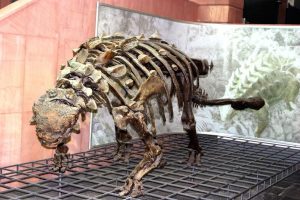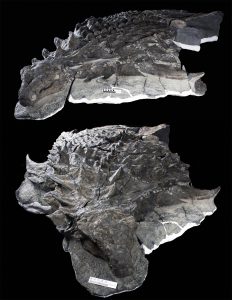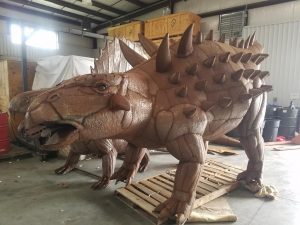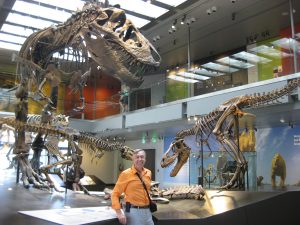The Ankylosaurus has been compared to a military tank. Some 65 million years ago this big, plodding creature covered from head to toe in impenetrable armor was furnished with offensive weapons that could cripple even the most ferocious predator. Ankylosaur is a genus for a large group of plated, armadillo-like herbivores. The Ankylosaurus is the largest member of the group and the last to survive. They could reach 33 feet long about the same size as an Allosaurus! Ankylosaurus weighted up to 8 tons! The body was very bulky measuring up to 6.5 feet in width. Although the skull was tiny, less than 2 feet in length. It was heavy and solidly fused with two horns projecting from the back on each side and a series of small interlocking oval shaped plates engulfing the roof. The most remarkable feature of Ankylosaurus was its club shaped tail resembling a mace. The club was nearly the size of its skull! The club tail was a deadly weapon that would have kept Tyrannosaurs and other predators from attacking. Below a typical fossil of Ankylosaurus (courtesy of Talismancoins.com)
On March 11, 2011 miners in Northern Alberta Canada at a huge oil sand quarry discovered the most well-preserved dinosaur ever! Although they didn’t know it at the time. Shawn Funk, a heavy-equipment operator noticed a change in the texture and color of the underlying rock where he was digging. Since Alberta is rick in fossils the construction crews are aware that any dig could potentially uncover fresh fossils. Funk called his supervisor and they alerted the Royal Tyrell Museum. During excavation the large block of rock broke in half. Fortunately, the pieces were carefully gathered and returned to the Museum for separating the fossil from the rock. It took technician Mark Mitchell over 5 1/2 years to complete the process. The fossil was so well preserved its skin was intact and resembled a statue no bones could be seen! The rock is so dense CT scans can’t even detect the bones.
The tail and rear were destroyed during the mining operation but the head and front part of the body are beautifully preserved. With such well-preserved skin scientists have identified chemicals in the skin that resulted in color estimates for this Dinosaur – Rust Colored Head and Back with a Light-Colored Belly. This genus of Ankylosaur is known as Borealopelta markmitchelli. The first half of the name is Latin for “northern shield” the second for the technician that separated it from the rock. The 110-million-year-old dinosaur lacked the tail club of some of its relatives. It’s back was covered in heavy armored scales and a pair of 20-inch-long spikes projected from it’s shoulders. It weighted 1.5 tons and was 20 feet long. Below photo courtesy of the Biophysical Journal Collection.
For more details see link below for the article in The Atlantic that includes a link to a video of the excavation. In addition, a link to another Ankylosaur discovery – Zuul crurivastator, named after the monster from Ghostbusters and Latin for “destroyer of shins” is in The Atlantic article.
A Metal Sculpture Artist has created an Ankylosaurus about 20 feet long. It’s tail was so high, a hinge for the tail was created for it to be attached and welded after it reached its destination or it would not have fit in the transport truck. The tail was not reattached when the photo below was taken.
Coming soon Angie gets cleaned-up and repainted after her “Dino Fest” Adventure and Halloween preparations at the Park!
“Encouraging the Appreciation of Art & Education through the Inspiration of Dinosaurs”
Paul & Prehistoric Pals
Your feedback is appreciated, Thank you!



